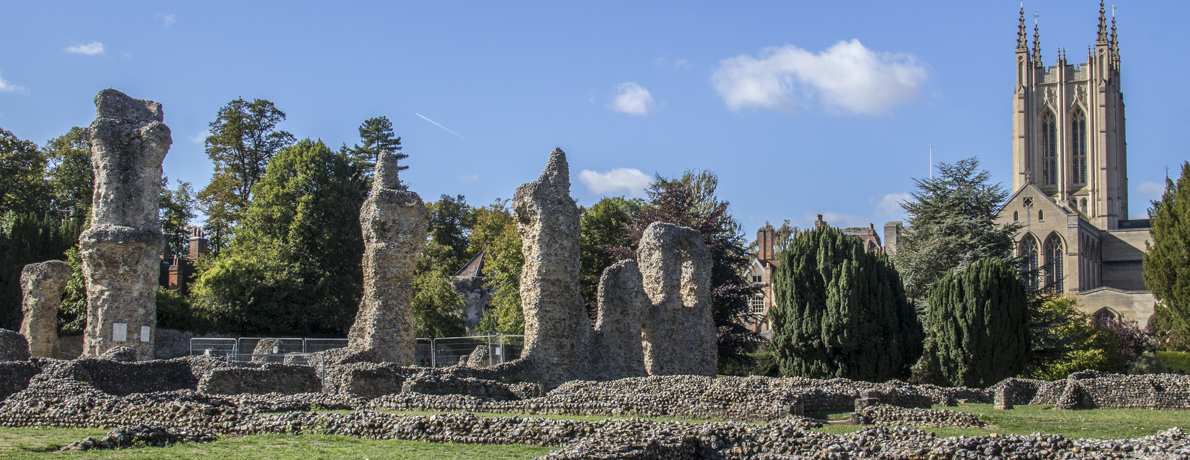
As it was in medieval times it remains so today. In Bury St Edmunds in Suffolk the Abbey is separated from the town. Although the Abbey itself was destroyed during the sixteenth century its grounds remain. Today, those grounds are still partly protected by the old walls but the public are no longer excluded. Abbey Gardens are a valued amenity treasured by the locals and appreciated by visitors.
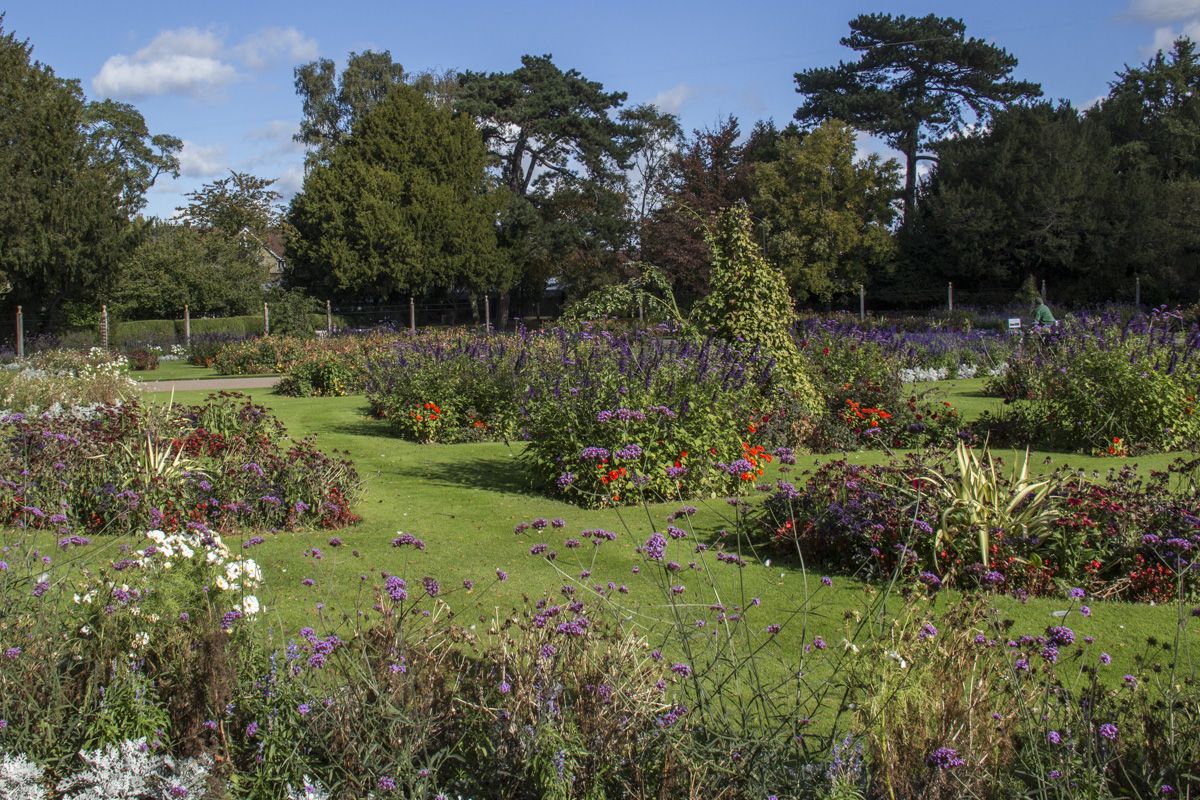
Formal garden in Abbey Gardens in Bury St Edmunds, Suffolk
The Abbey of St Edmundsbury
The main feature of Abbey Gardens are the ruins of the Abbey of St Edmundsbury. The body of Edmund the Martyr, King of East Anglia and first patron saint of England was brought to Bury St Edmunds in 903 after he was murdered in Denmark. The town soon became an important place of pilgrimage. The Benedictine Abbey was established here by Edward the Confessor in 1020 to house the remains of Saint Edmund. This Abbey was to become one of the most important abbeys in England in terms of both wealth and political importance. When it finally surrendered to King Henry VIII in 1539 during the Dissolution of the Monasteries it was still very wealthy. The abbey itself was quickly stripped for building materials and the whole site passed into private ownership in 1560. The Abbot’s Palace was the only building to survive. It was demolished by the owner of the abbey precincts in 1720.
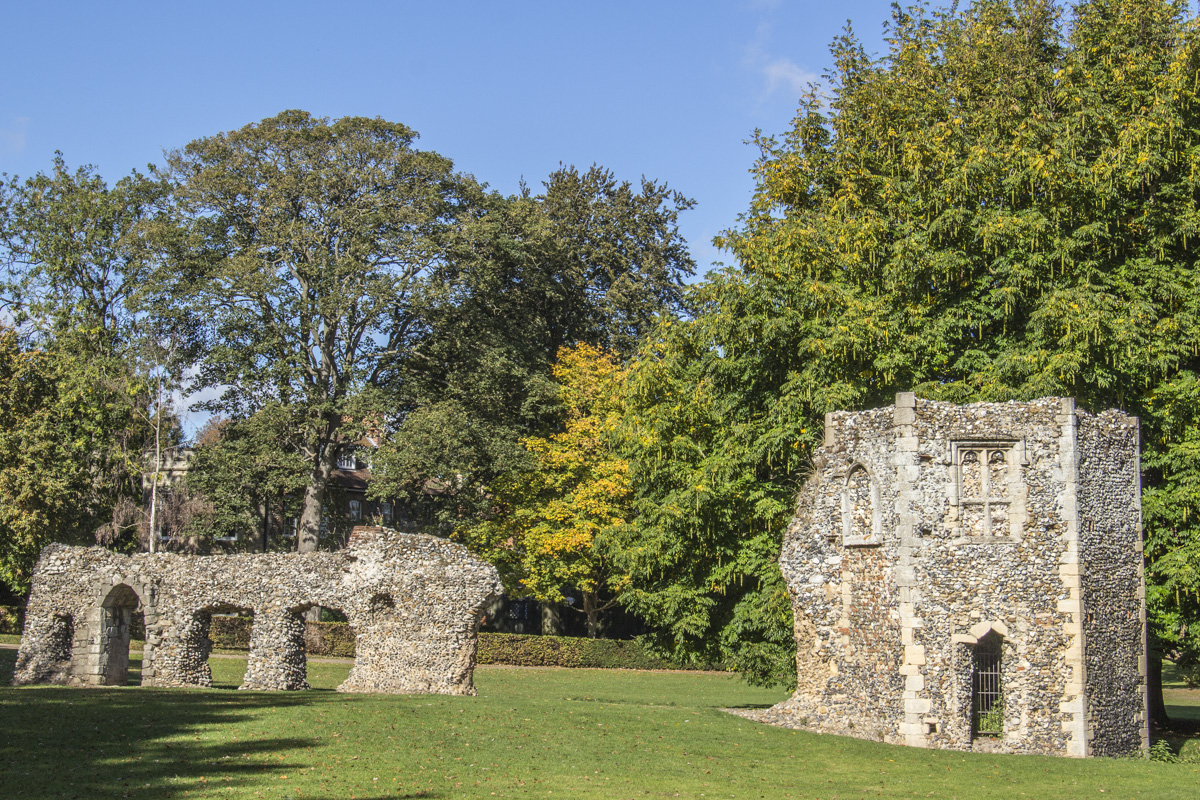
Remains of the Abbot’s Palace in Abbey Gardens, Bury St Edmunds, Suffolk
The Abbey Gardens
Over the centuries the precincts of the Abbey remained undisturbed. For many years, at the beginning of the nineteenth century it had been used been used as a private garden for Abbey House on Angel Hill. When the botanist Nathaniel Hodson arrived in Bury St Edmunds in 1820 it seemed this was the place where he could fulfil his desire to establish botanical gardens in a town that lacked such a facility and had local well-to-do inhabitants who might have the means to pay to visit the gardens. The Abbey Gardens were ideal for this venture and in 1831 he leased the land from the current owners, the local corporation and the Marquis of Bath. A house, Alwyne House, was built for Hodson in the gardens. After being used as a tea room for many years this house has once again become a private residence.
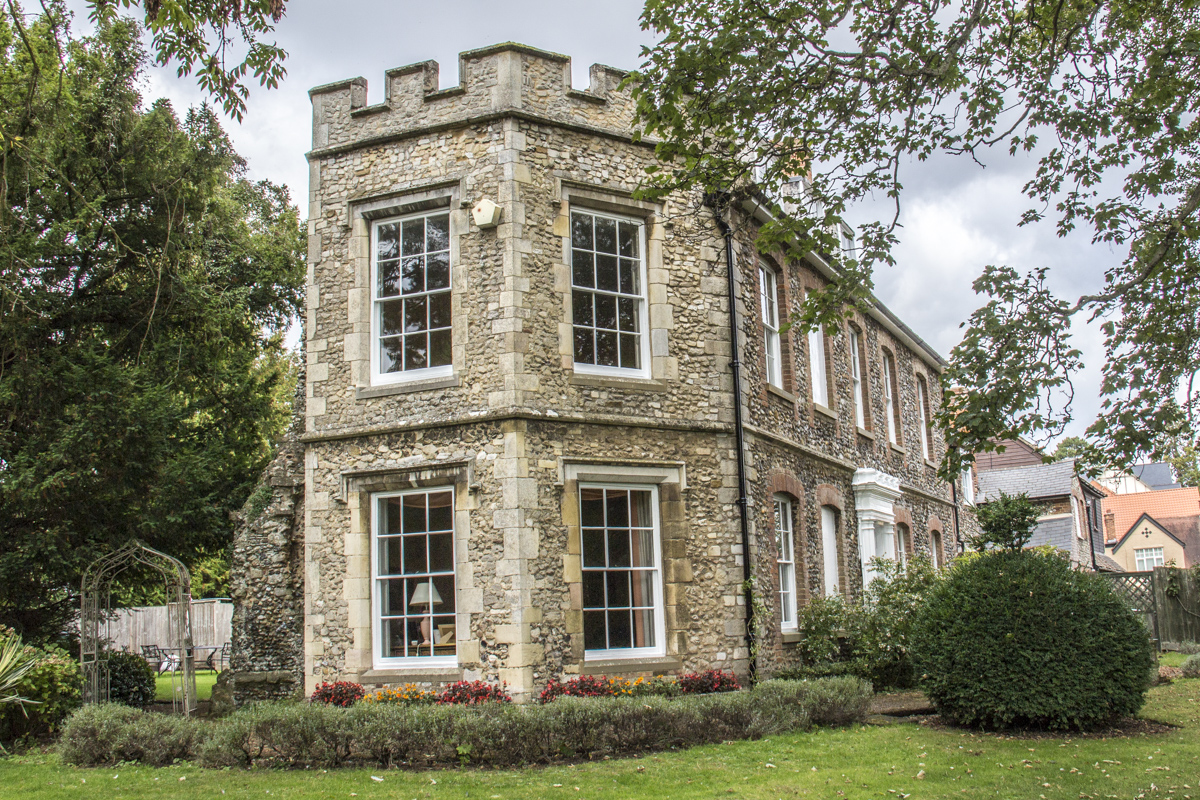
Alwyn House in Abbey Gardens in Bury St Edmunds, Suffolk
In 1835 Hodson introduced a small menagerie into the botanic gardens. This included rabbits, guinea pigs, pheasants, wildfowl and water birds on the River Lark that flows along one side of the gardens. The aviary survives to this day, the brilliantly coloured birds enchanting the children who come to the gardens. The Botanic Garden did not survive and has now been replaced by ornamental planting. Two major plantings take place every year, one in the spring for the summer display and one in the autumn for the spring display. An added attraction is the Sundial Fountain. In 1871 this Victorian drinking fountain, with a sundial cube on the top, was given to the people of Bury St Edmunds by the third Marquess of Bristol. It is a very early example of a sundial that allowed town clocks to be set to Greenwich Mean Time rather than local mean time. It was moved to the gardens from its original position in town, on The Traverse, in 1939.

Sundial Fountain in Abbey Gardens, Bury St Edmunds, Suffolk
The Gates to the Abbey Gardens
The main entrance to Abbey Gardens is at the top of Angel Hill through the Great Gate. This has been the main entrance to the abbey precincts since the fourteenth century when it led into the Great Court and the Abbot’s Palace. The impressive stonework is an indication of the quality of the work throughout the abbey. However, this is not the original gate. The all-powerful abbot was not very popular with his people during the riots of 1327 the Great Gate was destroyed. The walls of the abbey precinct would have been an easier target but it is believed that records of rents and property deeds were kept in the gatehouse which was the reason for its destruction. The people in the town were responsible for rebuilding the present gate in 1346.

Great Gate in Bury St Edmunds, Suffolk
Originally there were four gates in in the walls of the abbey but only two have survived. The Great Gate and St James Gate Norman Tower. Saint James monastic gate is now used as a belfry for the Cathedral Church of St James. This gate stands alone between the cathedral church and the Victorian Savings Bank House. This original gate was built during the twelfth century and restored by L N Cottingham in 1846.

St James Gate Norman Tower in Bury St Edmunds, Suffolk
When the site of the famous Abbey of St Edmundsbury and its precincts was taken over by the local Corporation to establish a public park the ruins of the Abbey were the main feature. Since then there have been some lovely additions to this popular park. Amenities include a play areas and the Garden Cafe. Visitors can also enjoy a series of small gardens, each representing a theme or a dedication.
The Harold Bonnet Sensory Garden
The first sensory garden was established in Abbey Gardens in 1990. It was designed to provide interest for the blind and visually impaired through scented plants and herbs. Thanks to a bequest a new garden was laid out in 2003 that is also suitable for wheelchair users. It includes a pergola designed to create the effect of a cloister where monks would once have walked.

Harold Bonnet sensory garden in Abbey Gardens, Bury St Edmunds, Suffolk
The Peace Garden
The Peace Garden, also referred to as the Garden of Quiet Reflection, was established in 2015 by the Memorial Garden Trust. It is dedicated to the fifty-seven Jews murdered in Bury St Edmunds on Palm Sunday in 1190 and all victims of genocide. In the centre of this peaceful, tree-shaded area is a large teardrop. It is surrounded by fifty-seven cobble stones, one for each victim of the twelfth century massacre. There are also stone benches for quiet reflection. Every year on January 27 a Holocaust Memorial Day Service is held in the Abbey Gardens.

Peace Garden in the Abbey Gardens in Bury St Edmunds, Suffolk
The Appleby Old English Rose Garden
The Appleby Old English Rose Garden was established in a corner of the gardens that was originally an orchard. It is named after John Appleby an American serviceman who was based in Lavenham near Bury St Edmunds. During the Second World War the flat fields of Suffolk were ideal for airfields and the majority of the nineteen that were set up here were used by the American air force. Appleby was clearly very fond of Suffolk as he wrote a book, Suffolk Summer, about his time there. When the book was published in 1948 he gave the copyright to the Borough Council of Bury St Edmunds. All royalties were to be used to maintain the Old English Rose Garden. This garden, a permanent memorial to the American servicemen who died in the cause of freedom, features a bench made from the wing of an American Flying Fortress Bomber and a memorial stone.
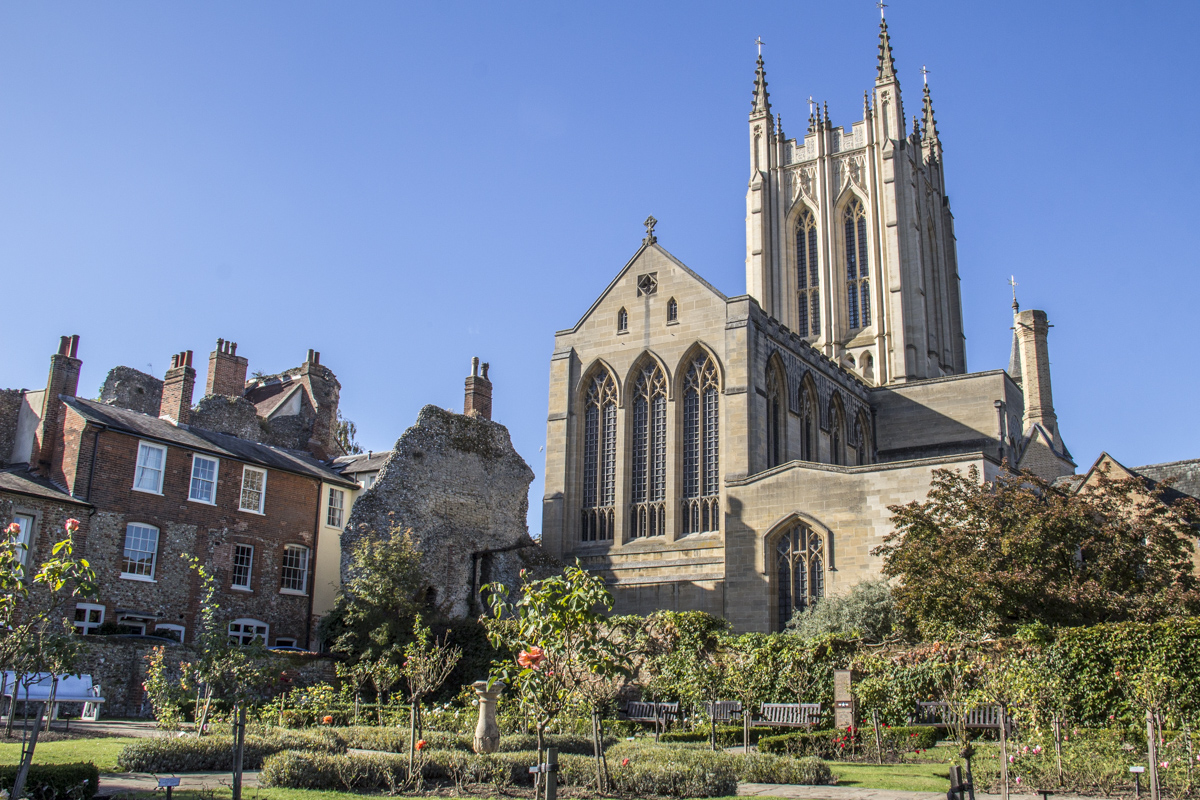
Appleby Old English Rose Garden in Abbey Gardens, Bury St Edmunds, Suffolk
The Water Garden
At the back of the Bowling Green (available to hire) is the small, enclosed Water Garden. It has been refurbished thanks to an anonymous, very generous benefactor and a regular visitor to the gardens. Shelters with ornate iron gates dating from the 1950s stand at each end of it. These are linked by a path that runs alongside a pretty pond. I found the splashing of water in the two fountains very soothing and spent some time here just enjoying its calming ambience.
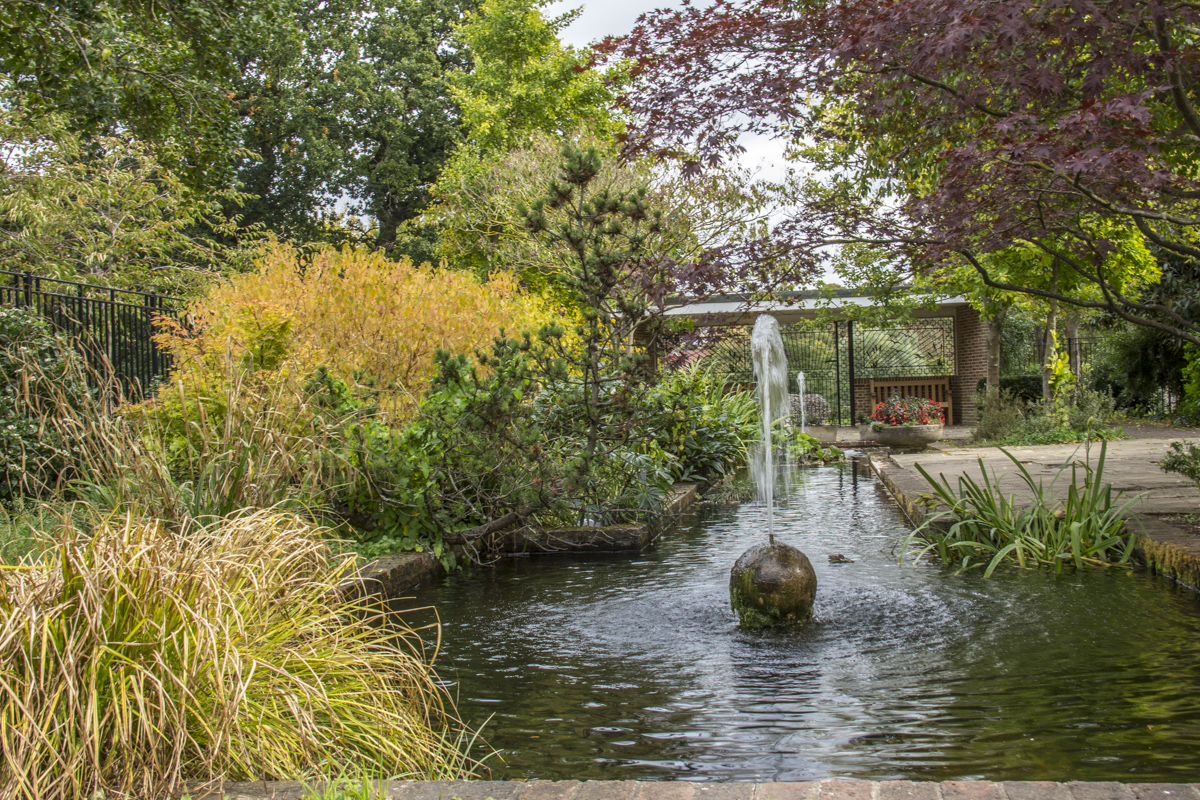
Water Garden in Abbey Gardens, Bury St Edmunds, Suffolk
The Riverside
After strolling through the ruins of the abbey I came to the banks of the River Lark that runs alongside the Abbey Gardens. It is hard to imagine boats plying their trade on its still waters disturbed only by the occasional water fowl but historically the Abbey used it for trade and the generation of power. The ancient bridge that was incorporated in the medieval precinct walls still spans the river. On the far side of this river is the wildlife feeding area in the shadow of a fourteenth century dovecote. This dovecote was built there to attract the pigeons so that visitors walking under the Great Gate were not troubled by them. Playgrounds have also been established in this, the most natural area of the gardens. A footbridge across the river leads on to a circular path that encompasses the Abbey Gardens, a Norman meadow and part of the old town.
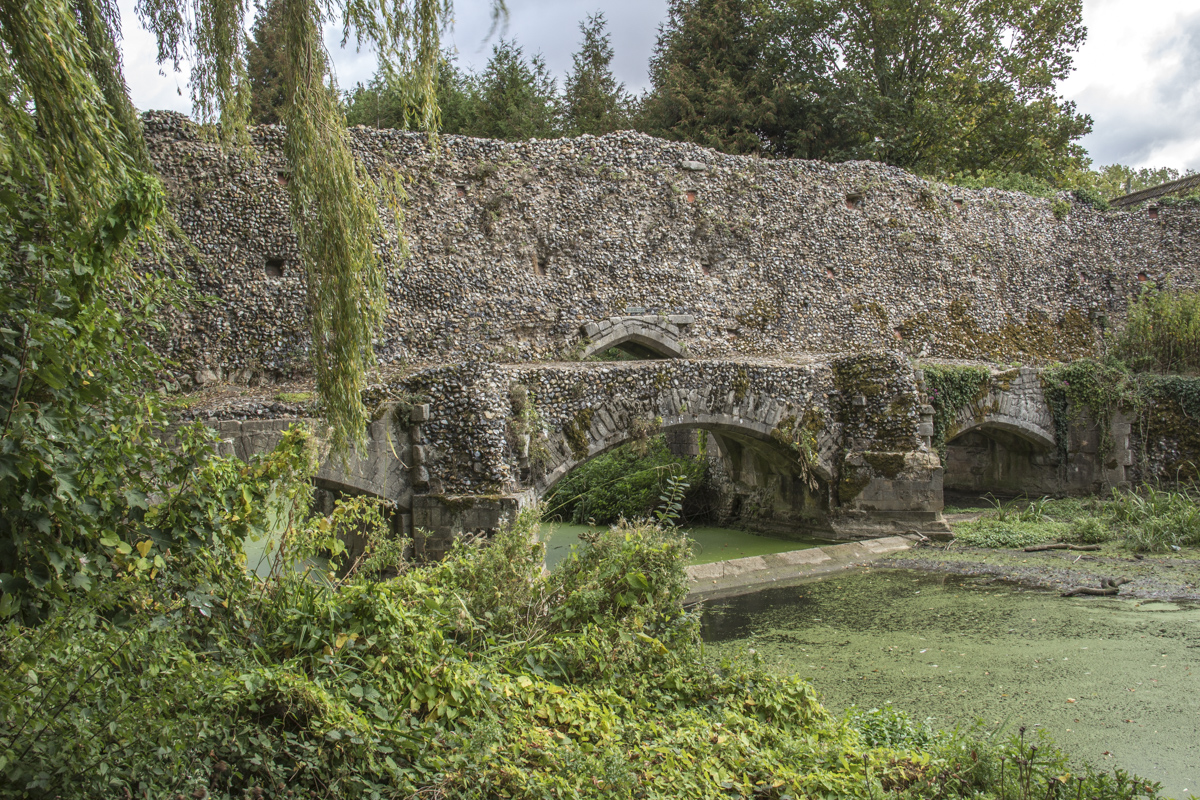
Abbot’s Bridge by the Abbey Gardens in Bury St Edmunds, Suffolk
The Pilgrim Herb Garden
By the time I had done a full circuit of the gardens I was ready for something to eat and followed the signs to the Pilgrim’s Kitchen. These led me through the Pilgrim Herb Garden. This garden was inspired by a famous manuscript that was written at the Abbey during the thirteenth century and which is now housed in the Bodleian Library in Oxford. Traditional medicinal plants believed to cure most ailments and ward off evil spirits are planted amongst regimented rows of tiny hedges. At the far end of the garden was a small archway that led me into the garden of the Pilgrim’s Kitchen. The bright, cosy interior was a lovely place to relax and refresh before moving on through the impressive cloisters of the Cathedral Church of St James and into the cathedral itself.
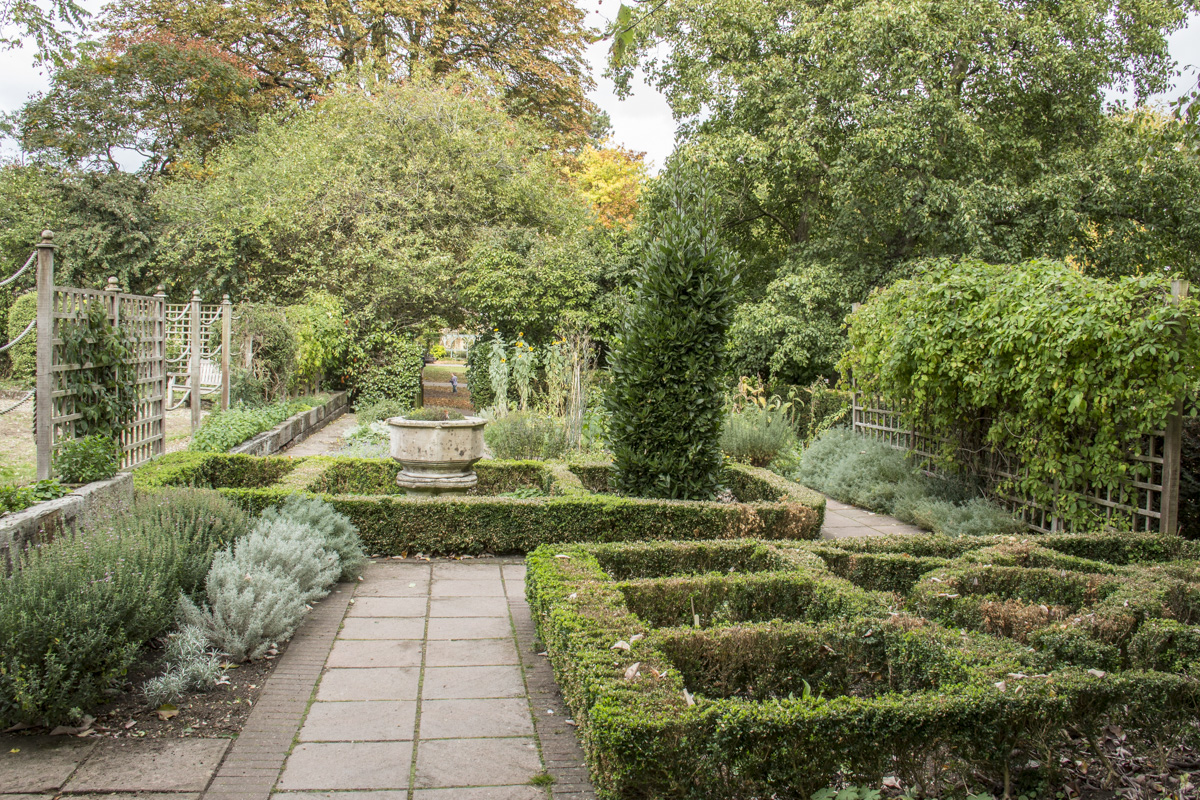
Pilgrim Garden in Abbey Gardens, Bury St Edmunds, Suffolk
Bury St Edmunds Cathedral
Originally there were three parish churches on around the precinct of the abbey but only two of these medieval parish churches have survived. One of them, the Church of St James became the cathedral in 1914. Very little remains of the original church built on this site apart from the nave of the church built in 1503. This church has continued to evolve with the addition of its impressive Cathedral Tower that was completed in 2005. Once the tower was completed it was decided to add the amazing vaulted ceiling and this was completed in 2010. Regular tours of the tower are organised and can be booked online. The ancient library is the oldest parish library in England. It was founded in 1595 as a resource for clergy training and contains over five hundred books, most of them printed in the sixteenth and seventeenth centuries.
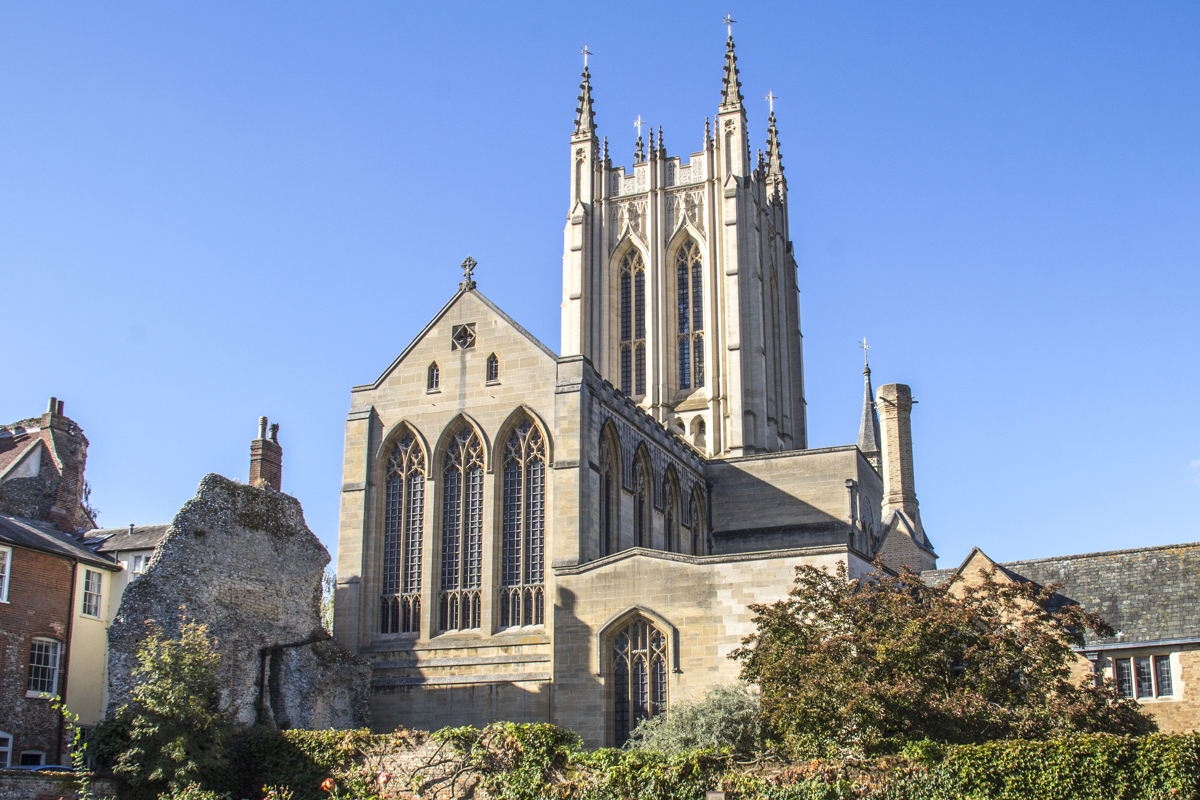
Cathedral Church of St James in Bury St Edmunds, Suffolk
The Church of St Mary
The second parish church to survive since medieval times is the Church of St Mary. Probably one of the largest parish churches in the country this church has the second longest aisle in the country and the largest west window. Mary Tudor, Queen of France and Duchess of Suffolk was laid to rest here. As well as some stunning Victorian stained glass windows the church also has a chapel dedicated to the Suffolk and Royal Anglian Regiments.

St Mary’s Church in Bury St Edmunds, Suffolk
On my way back into town I passed a statue of the man who started it all – St Edmund. He stands proudly in a courtyard in front of the cathedral.
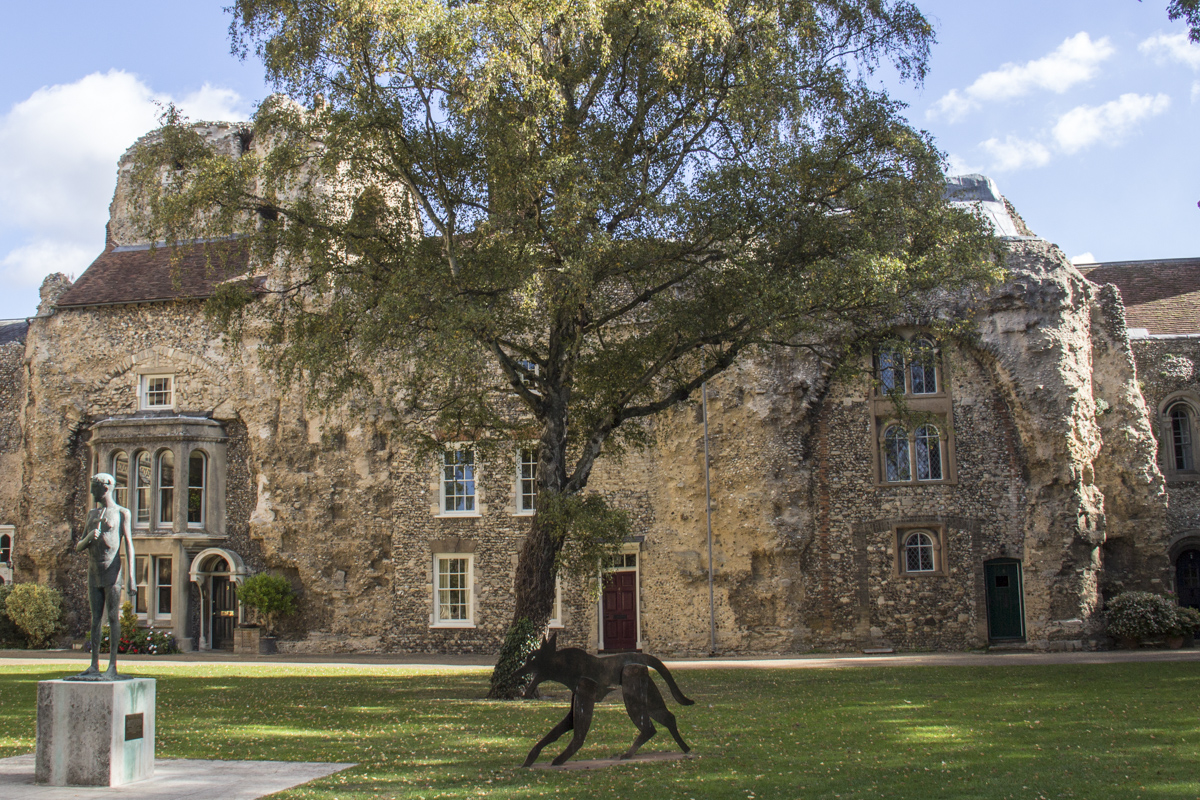
Statue of St Edmund in front of post-medieval houses built into the Abbey walls
Where to Stay
I can highly recommend the The Northgate, a luxurious, yet not outrageously expensive boutique hotel close to the city centre. The hotel has nine rooms, all beautifully furnished and well-equipped. Although the hotel is very close to the town centre on a reasonably busy road being set back from this road any traffic noise is not. A real plus is the lovely garden and terrace at the back – a delightful setting for anything from morning coffee to afternoon tea or a cocktail party. There is also plenty of parking beyond the garden – always a plus in a city centre hotel. This hotel, a short walk from the city centre is perfectly placed for anyone visiting the town.
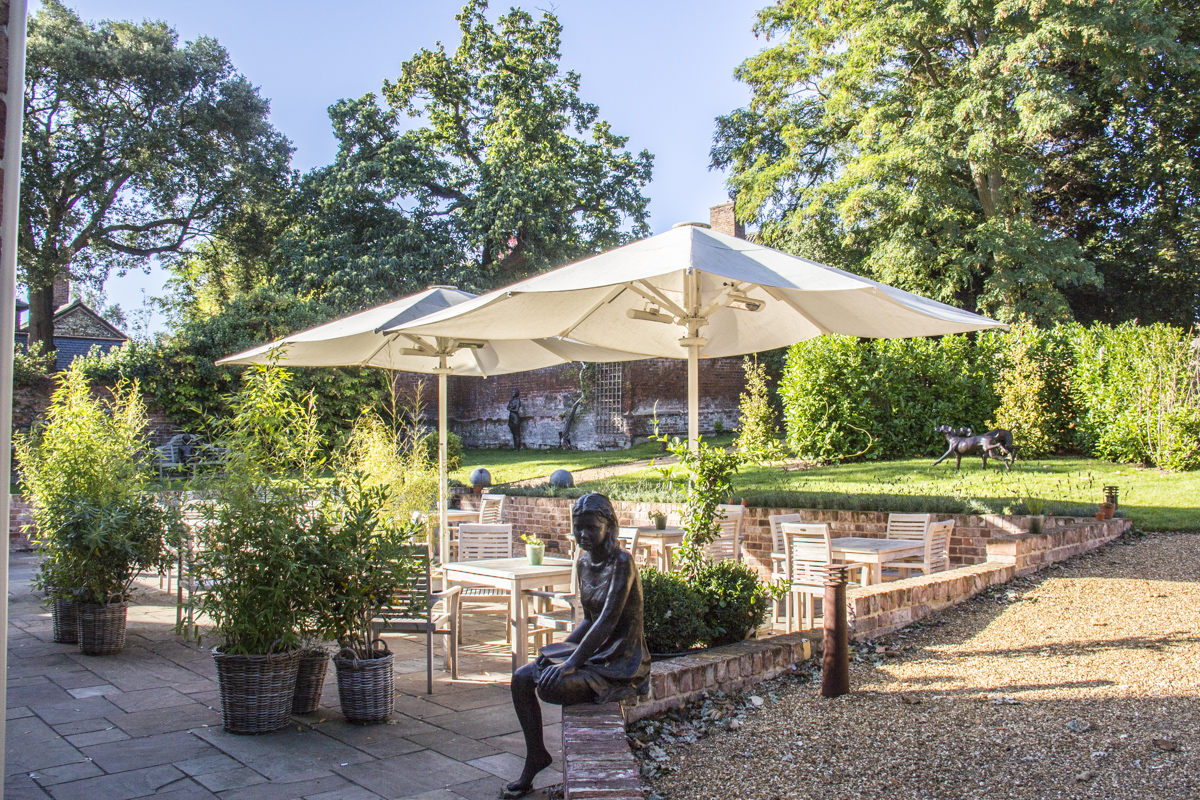
Garden at the rear of The Northgate in Bury St Edmunds, Suffolk
The Restaurant at The Northgate offers very fine dining in its restaurant using local, seasonal produce. The young staff are friendly, helpful and professional. My dining experience was exceptional, my breakfast was really good and throughout my stay I felt very welcome and well looked after. 
Starter at The Northgate restaurant in Bury St Edmunds, Suffolk
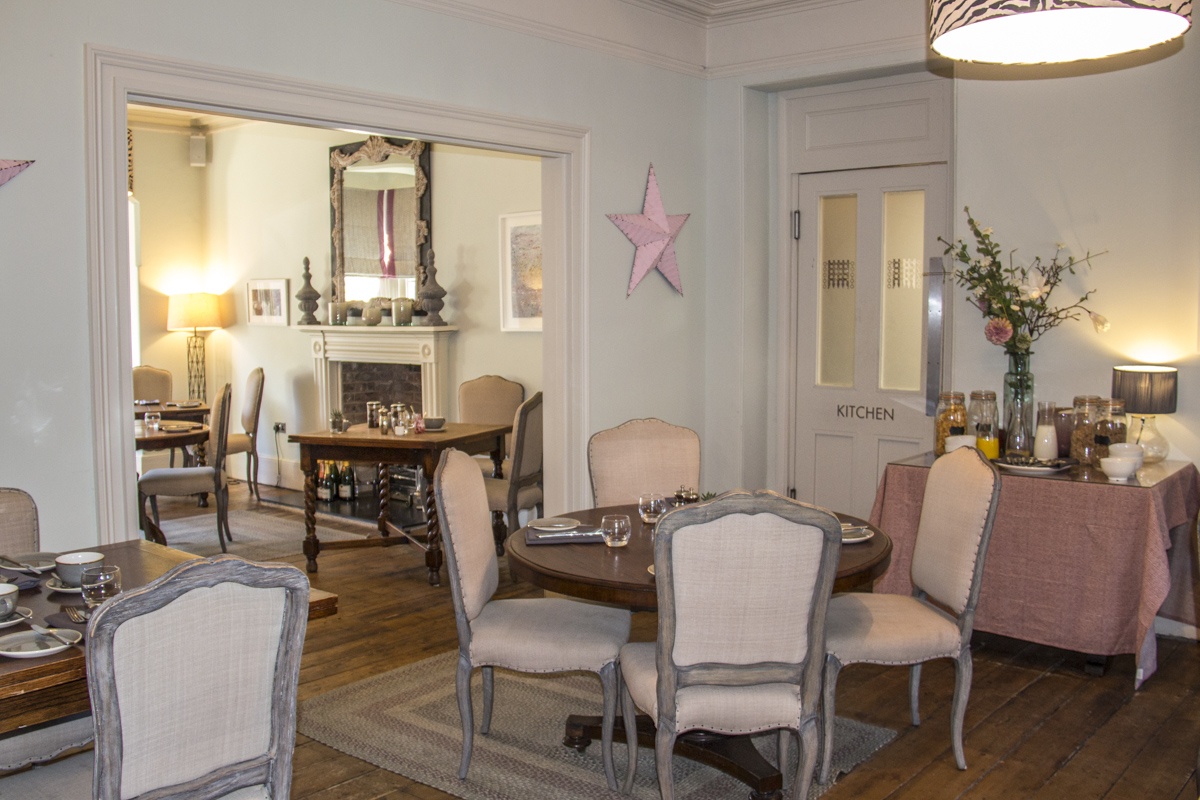
Restaurant set for breakfast at The Northgate in Bury St Edmunds, Suffolk
Available on GPSmyCity.com
This article is now featured on GPSmyCity. To download this article for offline reading or travel directions to the attractions highlighted in this article, go to Walking Tours in Bury St Edmunds on GPSmyCity
This article was based on the personal experience of Valery, an ExperiencedTraveller.